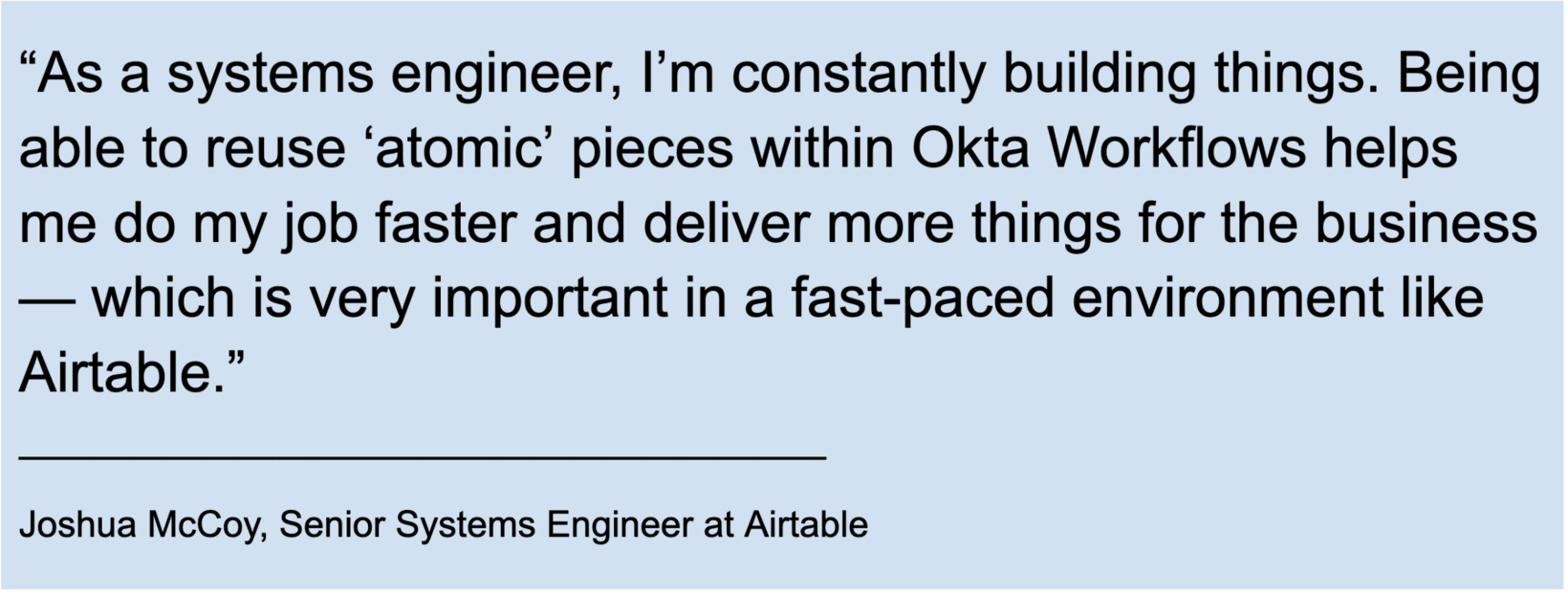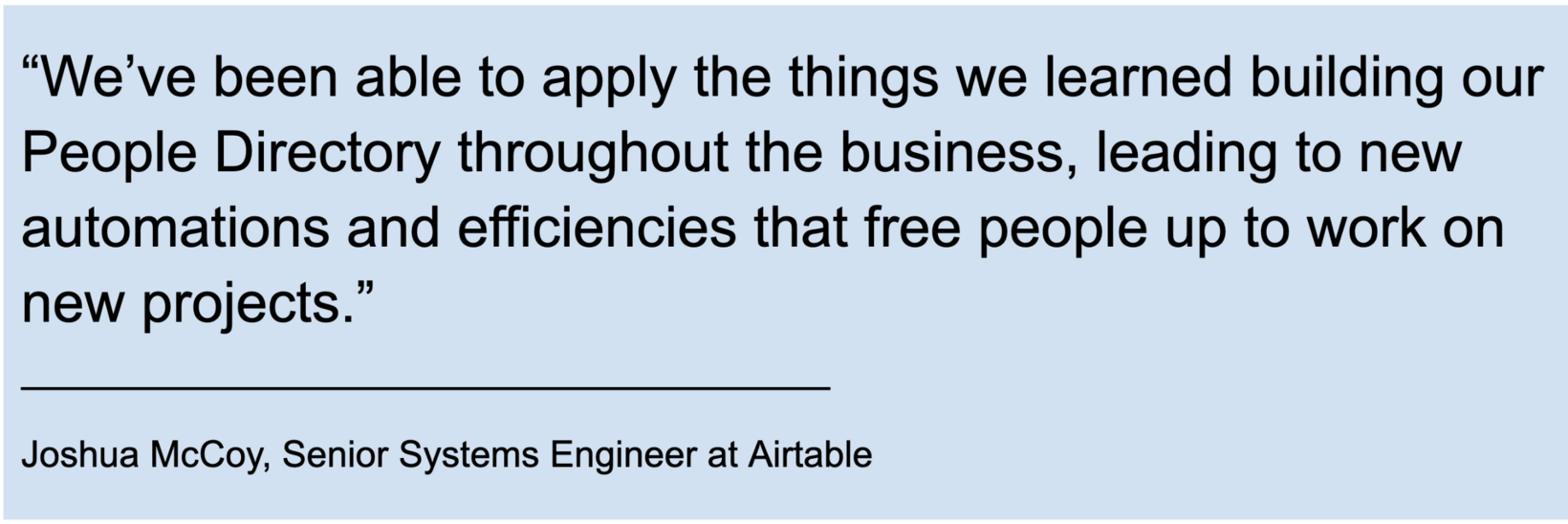Airtable sustainably scales automation with low-code Okta Workflows

Opportunity: Better enable and empower the entire workforce and improve IT efficiency by scalably and sustainably automating Identity-related processes
Airtable enables any team, regardless of technical skill, to create apps built upon shared data to power their most critical and unique workflows. Founded in 2013, the San Francisco-based company has since helped teams at more than 450,000 organisations — including 80% of the Fortune 100 — to connect their people and data.
Airtable’s commitment to innovation and advancement led Senior Systems Engineer Joshua McCoy to explore ways to:
- Introduce more automation throughout the company’s IT-enabled processes: Automation is key to unlocking scale, and while Airtable already had a considerable amount of automation in place, McCoy recognised more was possible.
- Seamlessly and securely equip Airtable’s employees with the access they need to fulfil their roles: Information is spread across many systems, but access has to be carefully controlled to maintain a strong security posture and protect privacy.
- Achieve those outcomes (and others) sustainably: A big-picture thinker, McCoy understood that a low-code approach was necessary to avoid introducing the maintenance burden that inevitably comes with a dependence upon custom code.
Approach: Using Okta Workflows and Connectors to implement and enhance no-code automation
When McCoy joined Airtable in August 2022, he brought with him eight years of hands-on experience using Okta for a wide range of workforce-related Identity applications. This expertise proved invaluable in his new role.
He stepped into an organisation that was already using Okta’s core Workforce Identity Cloud and Okta Workflows — a no-code Identity automation and orchestration platform — for lifecycle management (LCM) and Identity-related automations.
On top of this strong foundation, McCoy recognised even more opportunities to use Workflows to advance the highly automated, low-code vision Airtable was pursuing. He was especially drawn to “the flexibility of Okta Workflows to create custom automations across the enterprise tooling we already have in place.”
McCoy shared with us a few examples.
Powering a new-and-improved Airtable People Directory
The first major Workflows project McCoy pursued at Airtable was to automate the creation and maintenance of a comprehensive Airtable People Directory.
IT engineering worked with the HR technology team to set about building a new Airtable People Directory that would include the entire workforce, stay up-to-date with changes (e.g., leavers, movers, joiners), and would empower the entire organisation with a source of truth.
After about a month of collaborative planning, McCoy was ready to get to work.
At a high level, the directory works by using Workflows to retrieve information from Airtable’s Workday API, parsing the JSON data and transforming it as needed, splicing in additional information (e.g., GitHub user ID, Slack user ID), and writing it into an Airtable base. This flow allows the IT engineering team to carefully control what information each employee can access, limiting it to that necessary for their role and objective. As an example, McCoy notes that, “Colleagues can benefit from being able to look up a Slack ID, a management structure, who’s on a team, and so on, but shouldn’t have access to someone’s home address.”
The flow uses the Airtable connector, just one of many pre-built Connectors within Workflows.
There wasn’t a pre-built connector for Workday, but Workflows makes it easy to connect to any system via public API. As McCoy describes it, “Okta gives us the ability to use an API connector card, allowing us to pull data from practically any endpoint.”
The Okta API connector is straightforward, like the Python Requests library. You can send GET and POST requests, receive JSON and XML, and authenticate using OAuth. For developers, it just makes intuitive sense.
Using Workflows, McCoy can pull each active workforce member from Workday, determine if that team member exists in the directory, and add or update their profile as needed.
This new Airtable People Directory empowers the entire organisation, from addressing simple needs like getting the Slack IDs for everyone on a particular project to more complicated ones like powering additional automated processes for which a reliable and up-to-date index of the entire workforce is essential.
The feedback from the wider organisation is glowing, with McCoy sharing that, “The impact to the employee experience is huge, not only because we’re surfacing what’s going on in the business, but also because the directory is empowering other teams with a source of truth for their own integrations.”

And building a new Airtable People Directory was just the beginning. McCoy and the IT engineering team have been able to apply the lessons and hands-on experience they gained to introduce and enhance automation elsewhere in the business.
Accelerating IT processes with automatic log parsing
McCoy especially values that Workflows equips him with what he describes as “atomic” capabilities that can be reused in a plug-and-play manner.
Parsing and transforming data are two such examples, which in the past often required custom code.
Now, McCoy can call upon Workflows to perform these actions — leading to less code, much lower maintenance obligations, and shorter timelines to develop new IT engineering capabilities.
To illustrate the value, McCoy explains, “A lot of the work we do involves parsing JSON, and Okta Workflows handles this very well, and the pre-built connectors make things seamless. For example, this can be handy for error handling. If a job fails, I need to know what happened — how and why it failed. With Workflows and Connectors, I can easily digest log information, parse and transform it as needed, and send it to a Slack channel, which allows us to triage and address appropriately.”

Automating hiring and onboarding processes
Okta Workflows makes lifecycle management processes — like deprovisioning a user and transferring their files or nudging inactive customers to take action — simple, thanks to a library of connectors that includes Box, Slack, Salesforce, Marketo, OneTrust, and more, plus the ability to call APIs to customise workflows.
But, many aspects of LCM extend beyond managing access to data and apps. For instance, many steps must be completed before a new hire is ready to be onboarded — including the interview process itself, issuing an offer letter, performing a background check, confirming the offer is accepted, shipping equipment, and acquiring personal information (e.g., payment details).
Once again, working closely with the HR organisation, the IT engineering team leveraged the integration between Okta Workflows, Workday, and Airtable’s applicant tracking software and hiring platform to automate as many steps as possible.
McCoy explains how such integrations simplify shipping equipment to a new hire. “Through the integration with our hiring platform, we can detect when certain hiring milestones are met. Then, through the Workday connector we built, we can pull out the new hire’s address and whether they’re a Windows or Mac user. And we even have an integration with our courier, so we can create tracking labels to provide the new hire with real-time information about when their equipment is arriving. And Okta Workflows is at the core of all of this automation.”
Automating so many steps and processes within broader workflows means that team members throughout the business — from HR to IT to shipping and receiving — have more time and energy to spend on initiatives that propel the business rather than on tasks that contribute to the status quo.

Results: A more reliable, scalable, and sustainable IT infrastructure — and efficiency gains throughout the organisation
Airtable uses Workflows across a variety of IT engineering projects. Its benefits are felt in many different ways, but McCoy identifies a handful of key themes.
Scalability
The low-code approach of Workflows is much more conducive than custom code and scripts to scaling automations, allowing much more of the Airtable organisation to automate tasks and workstreams.
Sustainability
Building, maintaining, and extending flows is much easier with Workflows since doing so doesn’t depend upon coding capabilities.
“With the old directory, we had to maintain our own infrastructure,” McCoy points out, “which required pulling from a GitHub repository to update code and going through a series of checks.” Now? “Using Okta Workflows means we don’t have to do any of that.”
Cost Savings
For his part, McCoy estimates that IT engineering used to spend 5-10 hours a week building out features for the old directory, and he believes that the new low-code automation approach requires “only about a fifth of the time to build, maintain, and teach others,” resulting directly in “huge cost savings.”
Plus, additional automations — whether built by IT engineering, as in the examples above, or by other teams leveraging the Airtable People Directory — will have a similar effect throughout the organisation.
McCoy adds that decoupling the new Airtable People Directory from the cloud application platforms means the IT engineering team is one step closer to sunsetting that platform. “That’s a system that we don’t want to leverage going forward,” he says. “Consolidating around Okta Workflows really allows us to have a better — a tighter — tech stack, which, in turn, lets us focus more on what we need to do.”
Reliability
McCoy emphasises the importance of reliability. “Workflows is just very reliable, which is huge,” he says. “This is often an overlooked aspect, but if things run smoothly, then that means I’m doing my job.”

Moving forward with Okta
An Okta user since 2014, McCoy is used to learning and implementing new capabilities — and he came away from Oktane 2023 excited and inspired for what the future holds.
Topping the list of ideas the IT engineering team is considering include:
- Going passwordless: “It’s something our team is talking about, in terms of further strengthening our security posture and lowering friction for our users
- Automating org management with Terraform: “Being able to leverage Terraform and Okta — you already have a really strong integration — could be helpful.”

